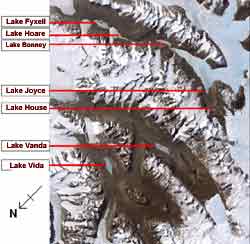
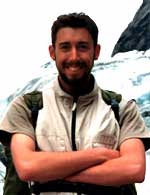

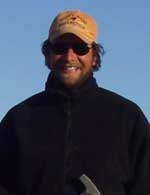
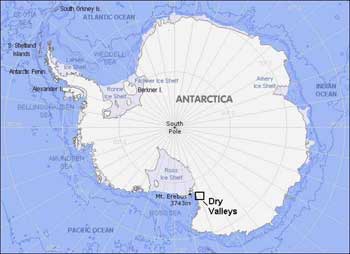
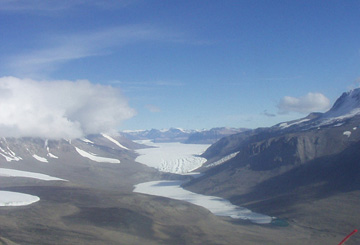
The lakes in the Dry Valleys are closed basin lakes. That is, they have no present outlet to the sea. The water levels of these lakes record the hydrologic variations, which are related to regional climate. Our past work here has shown that at times the lakes are as much as 400m deeper than they are now. To obtain a continuous water-level record, we are spending our second of two field seasons in the Dry Valleys taking sediment cores from the lake bottoms. To find out more, see the Project Description.
This field season we will begin ourfieldwork at Lake Vanda in Wright Valley. The lake is 70m deep at its deepest, and as such represents our biggest coring challenge this season. After completing operations at Lake Vanda we will put together a schedule to try and visit some or all of the the other lakes highlighted in the figure.
Tom Whittakar sums up the season:
I have now returned to the rather less adventurous aspect of our work, that which takes place in the office workspace back in Orono. But rather than being sad about trading the limitless magnificence of the Dry Valleys for the Geology Building here at UMaine I’m looking forward to getting my hands dirty sifting through the results of a phenomenal field season.
We made a good team, Brenda, Chris, Erica, Katie, Alex and I. Our individual strengths combined well to complete virtually any task we set ourselves, and also to cope with any difficulties that cropped up along the way. With various in-jokes, stories, slapstick comedy, and unfathomable inanities we were able make the most tedious of tasks that little bit more lighthearted.
This season we conducted research at Lakes Vanda and Brownworth (Wright Valley), Vida (Victoria Valley) Joyce (Pearse Valley), and Bonney (Taylor Valley), as well as at numerous ponds located in amongst the hummocky, boulder-strewn terrain of the Dry Valleys. Brenda and Katie made several hikes in Taylor Valley and Wright Valley searching for algae in old shorelines and deltas deposited higher up on the valley walls.
In the midst of all this we also made two day-trips north to the Convoy Range, the location of several other small ‘dry’ valleys. Here we investigated whether or not these valleys may have contained large proglacial lakes in the past, similar to those that formed in Taylor, Wright and Victoria Valleys. (Proglacial is a term that in its literal sense means 'something directly in front of glacier ice'. So the lake I describe is one that is bordered on one side by an ice margin.)
We had many goals for the season, not the least of which from my point of view, included Lake Frywell sediments that will constitute the basis for my Master’s thesis. We were able to accomplish a great deal in the short time we had at each field site, and made a significant number of extra discoveries at Lake Frywell. All in all we had a very successful season.
Cheerio

